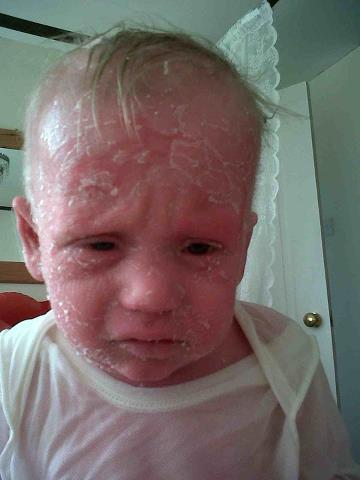About Netherton Syndrome
Are you unsure if your child has NS, have a read of some information below, it will explain to you a few fact's from various sources about the condition. Hope it can point you in the right direction.
Who diagnosed it?
Netherton Syndrome was 1st given its name in 1958 by Earl W.Netherton. He described a 4-year old girl with scaly red skin and different hair (which he called bamboo hair) because of how it looked in the microscope.
9 years earlier, the Italian dermatologist Come described a condition in a young woman with a ring shape change in her skin, which he called itcthyosis Linearis circumflex. These 2 description were considered to be related.
Jack Oldacres (Right) wasn't diagnosed straightaway with NS, and in his first few months doctors couldn't tell Danny and Julie what was wrong with Jack's skin.


What has caused this condition?
Netherton Syndrome is caused by damage in a gene called SPINK5, located on the long arm of the chromosome 5 (5q). This gene controls the formation of a protein (LEKTI) which is in the skin and the thymus.
LEKTI inhibits certain enzymes in the epidermis. Enzymes are responsible for breaking down the links between the horn of cells thus enabling a normal rejection in the skin cells. In the absense of the LEKTI there is a rejection of the horn cells, resulting in flaking, red skin, The skin can become very dry and sore, but also it will absorb any creams used on the skin very easily.
What can be done to help cope with Netherton Syndrome?
There is still no treatment that cures the disease, but efforts are being made to find this cure at Great Ormond Street Hospital in the UK, and various hosptial in other counties including America.
The condition requires visits to the hospital to visit both the Dermatologist and the ear specialist as these are 2 areas that need constant checks. (because of skin blocking the ears as it flakes) The 1st year of a child life is the most important. The need to be monitored very close as infection is very high so care using incubator are essential, Fluids and salt balance are monitored as the loss of fliud through the skin is rapid and can also cause diarrhea and vomiting. The skin needs to be cared for several times a day using various mxtures of papaffin and vaseline.
During the neonatal period it is very important to pay attention to less serious infection to the skin and other body parts, as they can quicky develop into life threatening infection because of the delicate nature of the skin.
The use of a dietitian is important in the 1st year of life, any allergies are a risk to the child so teachers, carers should always be kept informed of this.
Daily treatment of the skin is important.(Jack below before his morning bath) Showers or baths at least twice a day are recommended and lubrication is necessary. The bath or showers will help soften the skin and it makes it easier to remove loose skin flakes by hand or with the use of a cloth. Regular care of the skin and hair is time consuming but in the long run will help the childs comfort.
When using creams care should be taken to check the additives in the creams. There is risks for example Salicylic acid, urea, propylenglycol and cortisone is absorbed into the blood through the thin skin. The use of moistursing cream without additives is recommended, especially for small children. A weak corticosteriod are sometimes required to dampen inflammation, eczema and rhe servere itching of the skin. This treatment is normally prescribed by a doctor.
For Itching, especially if it is related to allergy, anti-histamine tablets can help.
Nethertons do suffer from a poor tempature control, it is therefore important to prevent overheating, air condition is valuable when driving a car in hot days. Also worth carryng with you a bottle of water with a spray to or a wet towel in a cool bag. but not just hot day are affected in the winter child will feel the cold too and may need to be more protected then as they would in the summer.
